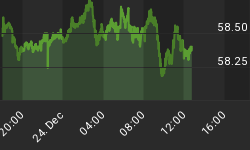Household Survey - The unemployment rate edged down to 4.6% in May after a string of three monthly readings of 4.7%. However, there are mixed messages in the details of the household survey. The share of job losers and those laid off has climbed up to 50.0% in May, from a low of 46.7% in March (see chart 1). The statistic "job losers as a percentage of the unemployed" tends to be a leading indicator of the overall unemployment rate. Another "internal" that takes some of the bloom off the unemployment-rate-decline rose is that 55% of the 288,000 Household Survey employment increase resulted from increased part-time workers.
Chart 1
Establishment Survey - Payroll employment rose only 75,000 in May, following gains of 175,000 and 126,000 in March and April. The downward revisions of March and April estimates led to a net loss of 38,000 jobs. Payrolls have risen only 146,000, on average, in the first five months of 2006 vs. a gain of 165,000 in all of 2005.
Factory employment fell 14,000 in May, after a gain of 19,000 new jobs in the prior month. Construction jobs rose only 1,000 in May. In the three months ended May, construction payrolls have increased on average less than 3,000 per month. In the 12 months ended February, monthly increases in construction payrolls averaged about 27,000. The weakness in construction employment reflects the fading momentum of the housing sector and highlights the importance of this sector to overall employment growth during this cycle. The manufacturing man-hours index dropped 0.3%, suggesting a soft industrial production report for May. Hourly earnings edged up only one cent in May to $16.62. On a year-over-year basis, unadjusted average hourly earnings were up 3.5% in May vs. 4.2% in April. The 0.23% decrease in average weekly earnings in conjunction with the only 67,000 increase in private payrolls points to a minuscule increase in May wages and salary income.
Chart 2
Conclusion - The overall weak tone of the May employment report is clearly supportive of a pause in interest rate hikes at the June 28-29 FOMC meeting. The May employment report is part of a pattern of evolving weakness in economic growth heralded by leading indicators such as the narrowing spread between the yield on the Treasury 10-year note and the fed funds rate and the weak growth in real M2. After having increased at an annualized rate of 5.2% in Q1, real PCE is on track to grow at 1-1/2% or less in Q2 based on the decline in motor vehicle unit sales and the decline in the ICSC - UBS Warburg retail same-store retails sales index in May. Based on the April construction spending data and various other related data, residential real estate will be a drag on Q2 real GDP growth. The ISM manufacturing data point to some softening in the industrial sector as evidenced by the three consecutive declines in the new orders index. The fever in commodity prices appears to have been broken and the TIPS break-even spread, a measure of inflation expectations, also has gone down some. We assume that that the FOMC is well aware that consumer price inflation is a lagging economic process. So, unless the FOMC is prepared to run the risk of recession either late this year or early next, it will pause now in its interest rate increases. We do not think the FOMC is willing to risk a recession at this juncture. Therefore, we do believe the FOMC will stand pat at its upcoming June 28-29 meeting. Moreover, we are of the opinion that the FOMC's next change in the fed funds rate will be to cut it - probably at the December 12 meeting.
HIGHLIGHTS OF THE EMPLOYMENT REPORT - MAY 2006
















